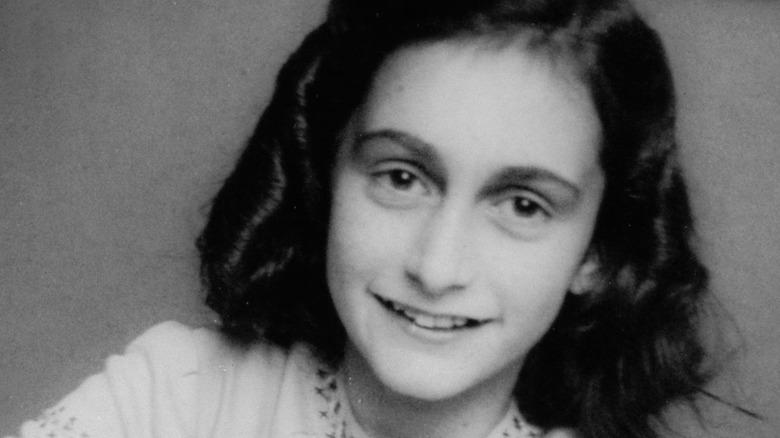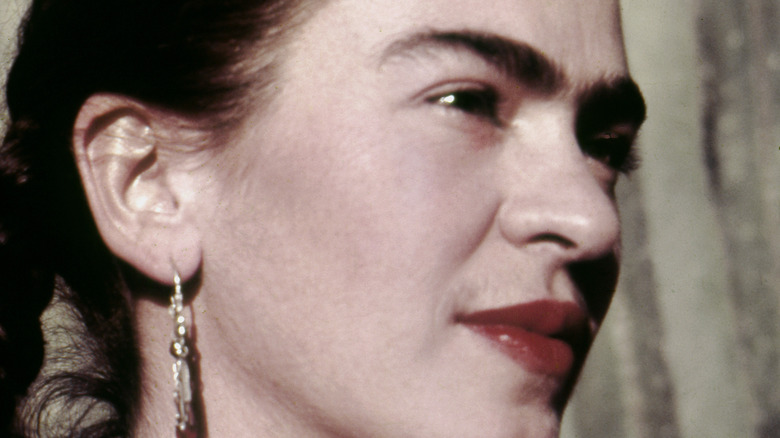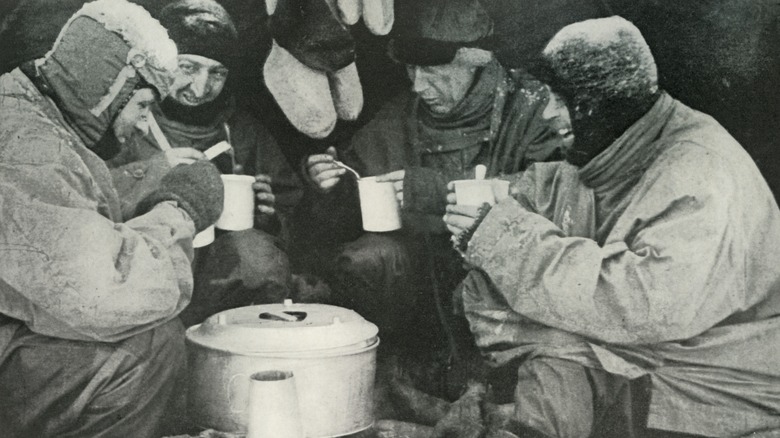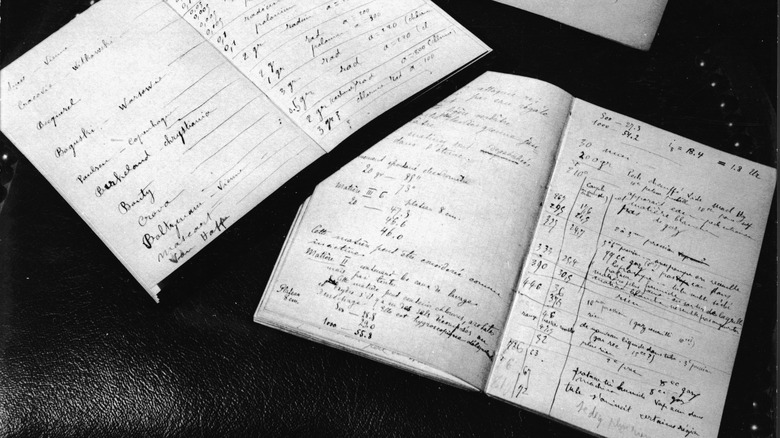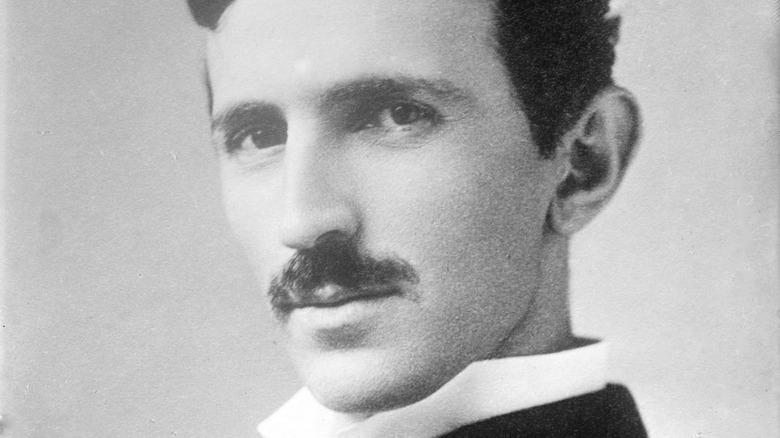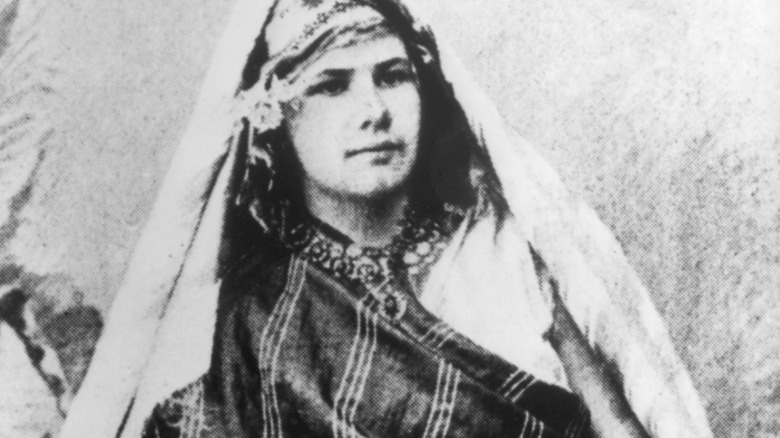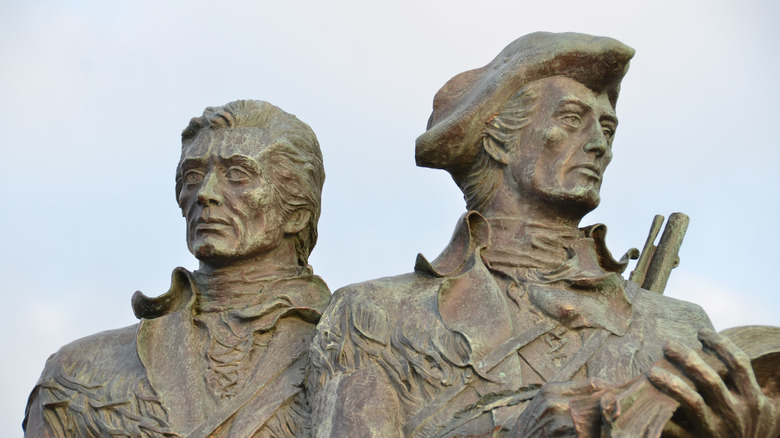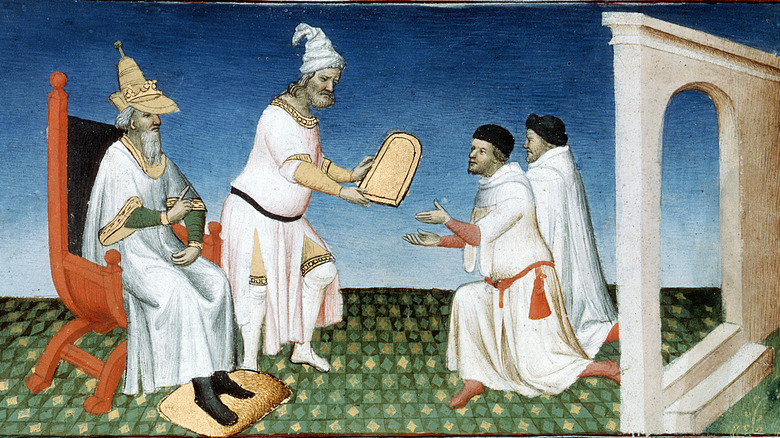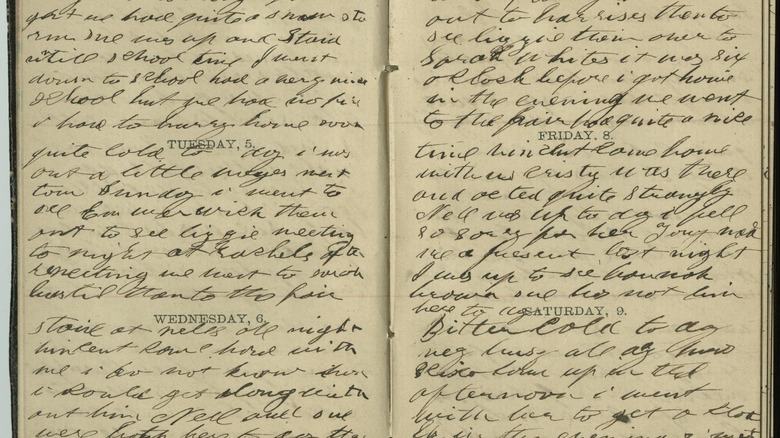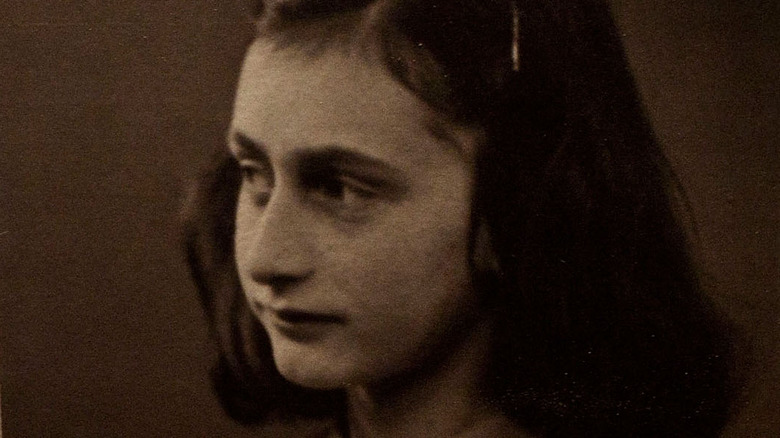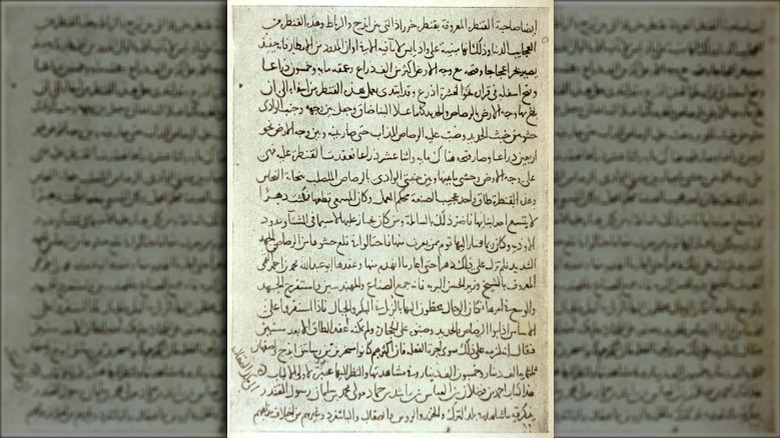The Stories Behind Some Of The World's Most Famous Diaries
Did you know that keeping a diary comes with significant psychological benefits? Experts at Kaiser Permanente report that journal-keeping is akin to self-care. What's more, people who jot down the daily happenings in their lives enjoy reduced anxiety and stress, increased memory, and improved self-confidence. Why? Because journals help you gain perspective while looking back and maintaining a record of what you've done and all you've overcome. Purging unwanted or unproductive thoughts and feelings on paper may also assist you in focusing better for important tasks.
Perhaps this explains why some of the world's most famous, innovative, and talented individuals never left home without a diary. They include wildly creative non-conformists like Frida Kahlo and Isabelle Eberhardt and gifted, meticulous innovators such as Marie Curie and Nikola Tesla. But you'll also find myriad travelers whose journals helped them document extraordinary experiences, like Marco Polo, Lewis and Clark, and Ahmad Ibn Fadlan. Some diaries leave readers feeling haunted by the tragedies that unravel on their pages, including the diaries of Robert F. Scott, Anne Frank, and the Dyatlov Expedition.
To truly appreciate the world's most famous diaries, you need to understand them in context. Here's what you need to know about the stories behind some of the world's most famous journals.
The intimate self-portrait of an artist
One of the most famous painters Mexico has ever produced, Frida Kahlo continues to entrance museum-goers and art lovers with her vibrant canvases. Her work showcases dynamic scenes inspired by Mexican folklore as well as local plants and animals. Disabled by polio as a child, she remained an ambitious student with her sights set on medical school. But fate had something else in store for the young woman.
In her late teens, a catastrophic bus accident nearly killed her. According to Frida Kahlo, "she suffered multiple fractures of her spine, collarbone, and ribs, a shattered pelvis, broken foot, and a dislocated shoulder." Her excruciating recovery involved a body cast and 30 operations. She turned to art as a means of comfort and self-expression. Many of her 143 paintings prove highly autobiographical. Fifty-five of those works are self-portraits. But beyond her incredible canvases, Kahlo also left detailed journals providing insight into her work and famed relationship with fellow artist Diego Rivera, whom she would eventually marry twice, per DiegoRivera.org.
Discussing her love affair with Rivera, she wrote, "You too know that all my eyes see, all I touch with myself, from any distance, is Diego. The caress of fabrics, the color of colors, the wires, the nerves, the pencils, the leaves, the dust, the cells, the war and the sun, everything experienced in the minutes of the non-clocks and the non-calendars and the empty non-glances, is him" (via Scribd).
A harrowing account of an ill-fated adventure
During the winter of 1911-1912, two teams raced to the South Pole, as reported by History. Norwegian explorer Roald Amundsen led the first group, relying on sled dogs throughout. The other, headed up by the British adventurer Robert F. Scott, included Siberian ponies, dogs, and motor sledges. On December 14, 1911, Amundsen's crew reached the Pole first, enshrining the team's place in history. But Scott's crew lagged dangerously far behind.
The motor sledges failed, and the British team was forced to shoot the Siberian horses, ill-equipped for such extreme temperatures. After sending back their dog teams, the crew continued on foot through the bitter cold. Reaching the South Pole more than a month after the Norwegian crew, Scott's expedition now raced a more formidable foe, death itself. The story of Robert Falcon Scott and his team during their ill-fated 1910 expedition to the South Pole would've remained a mystery if it weren't for a diary discovered in the remains of their final camp, as reported by Eyewitness to History.
Sadly, they perished just 11 miles from their base camp. According to the British Library, Scott's journal describes the frantic last days of the expedition. His narrative of the team's tragic attempt to survive culminates with the statement, "Had we lived, I should have had a tale to tell of the hardihood, endurance, and courage of my companions which would have stirred the heart of every Englishman. These rough notes and our dead bodies must tell the tale," per Goodreads.
The radioactive laboratory journal detailing Nobel Prize winners
Marie Curie kept laboratory journals detailing her and her husband, Pierre Curie's experiments on radioactivity (via the Christian Science Monitor). The couple's work earned them the joint Nobel Prize in Physics in 1903. Curie was the first woman to garner a Nobel Prize, and she shattered the status quo in 1906, becoming the first female professor at the University of Paris.
But the Curies didn't realize they'd become a part of their own science experiments. As it turns out, they lived in a world infused with highly dangerous radiation. Today, Marie Curie's journals remain so dangerous, you must wear protective gear and sign a liability waiver to view them outside of their special lead-lined cases. Unaware of the grave toll the radiation took on her health, she kept radium and polonium stashed in her shirt pockets and desk drawers.
Remarking on its strange properties, Marie Curie would write, "One of our joys was to go into our workroom at night; we then perceived on all sides the feebly luminous silhouettes of the bottles of capsules containing our products. It was really a lovely sight and one always new to us. The glowing tubes looked like faint, fairy lights." Scientists say her journals and other belongings will remain radioactive for the next 1,500 years, per ScienceAlert. By 1911, she'd won a Nobel Prize in Chemistry based on her discovery of two new elements, radium and polonium. Exposure to these elements would lead to aplastic anemia and her death in 1934.
The lost journals of one of the greatest inventors
Along with Michael Faraday and Thomas Edison, Nikola Tesla remains one of the most prolific scientists and inventors of the 19th and 20th centuries (via Smithsonian Magazine). Many people fail to realize that the controversial scientist kept journals where he recorded detailed explanations of his experiments, as reported by PBS.
Most people think of Tesla and electricity as synonymous. But the famed scientist also invented "Tesla Coils" capable of transmitting and receiving radio signals. "Tesla Coils" also provided a foundation for new forms of light, including fluorescent lights, neon lights, and X-rays, according to Anil Rajvanshi on Research Gate. He also worked on a second device known as the "Tesla transformer," as reported by Aleksandar Marincic via Research Gate. Tesla remained obsessed with the concept of wireless transmission and attempted to build a massive tower for relaying radio waves. To say the least, he remained ahead of his time.
What did the forward-thinking scientist ultimately hope to achieve? Tesla wrote of the tower, "As soon as completed, it will be possible for a businessman in New York to dictate instructions, and have them instantly appear in type at his office in London or elsewhere. He will be able to call up, from his desk, and talk to any telephone subscriber on the globe, without any change whatever in the existing equipment" (per Smithsonian Magazine).
The inner thoughts of a dauntless explorer
Isabelle Eberhardt, a 19th-century Swiss-Russian writer and explorer, kept a detailed journal of her travel experiences, including a voyage from Switzerland to Algeria. Eberhardt describes everything from dabbling with marijuana to riding through the Sahara on horseback and taking on the persona of an Arabic pilgrim named Si Mahmoud Essadi, per The Guardian. By her late 20s, she'd aged well beyond her years.
According to the Paris Review, a perfect storm of bad habits and maladies undid her, including alcohol and drug abuse, malaria, and possibly syphilis. She also suffered constant pain after nearly getting her arm chopped off by a rival. As an adherent of Islam, more specifically Sufism, Eberhardt chalked it all up to mektoub or fate.
A casualty of a flash flood in the Atlas Mountains in 1904, Eberhardt was just 27. Fortunately, her journals survived the deluge, providing colorful glimpses into the adventurer's life (via The Guardian). Whether reveling in religious asceticism or debauchery and drug abuse, she maintained a disaffected air: "No one ever lived more from day to day than I, or was more dependent upon chance. It is the inescapable chain of events that has brought me to this point, rather than I who have caused things to happen."
A transcontinental tale recorded for posterity
When William Clark and Meriwether Lewis embarked on their transcontinental journey across North America, they kept detailed records of who and what they encountered in their journals (via the National Archives). Their journals contain everything from what they ate for dinner to detailed observations of new species such as Lewis's Woodpecker.
Lewis and Clark's expedition (aka the Corps of Discovery) traveled from 1803 to 1806, eventually reaching the Pacific Ocean. Along the way, they enjoyed both incredible adventures and challenging deprivations. With the help of a young Shoshone mother named Sacajawea, they crossed terrain never before traversed by Americans, recording invaluable insights about the peoples, plants, animals, and lands they discovered along the way. Their journals became an invaluable source of information.
Before setting out, the men had all sorts of expectations about what they'd see. After all, Americans had no clue what lay beyond the Rocky Mountains. Although they never ran across wooly mammoths or Welsh-speaking natives, the equivalent of early 19th century "urban" legends, what the expedition uncovered proved priceless from a scientific perspective. According to History, they discovered and described an astonishing 300 new species of flora and fauna, including grizzlies and coyotes. Walter Kim argues, "If not for the ... epic the captains scratched out while crouching on hillsides and squatting on riverbanks, we might not remember Lewis and Clark at all," per the Journals of the Lewis & Clark Expedition.
The recollections of a true merchant of Venice
One of Europe's oldest travelogues is the journal of Marco Polo, in which the Venetian explorer and merchant detailed his travels in Asia, per World Digital Library. His journal proved a sensation to Europeans, and it expanded their understanding of the affluence and vastness of the planet. Polo's travelogues became prized possessions that the kings and queens of Europe vied for. At one point, King Charles V of France owned at least one of the explorer's manuscripts, and this would eventually end up in the library of Queen Christina of Sweden.
In his journals, Polo provides some of the earliest encounters ever recorded between the Chinese and Europeans. Polo ventured east with his uncle and father in 1271, arriving four years later at the court of China's Mongolian ruler, Kublai Khan, grandson of Genghis Khan. Polo spent 17 years serving Kublai Khan and recording exciting details about his experiences in China (then known as Cathay).
Polo describes the palace of Khan this way, "It is the greatest palace that ever was ... The roof is very lofty, and the walls of the Palace are all covered with gold and silver. They are also adorned with representations of dragons, beasts and birds, knights and idols, and sundry other subjects" (via Columbia). The infamous explorer Christopher Columbus would later pour over a copy of Polo's journals, leaving handwritten notes in the margins as he prepared for his own voyage of discovery.
The pocket diaries chronicling the American Civil War
From 1863 to 1865, Emilie Davis kept three pocket diaries recording her life as a free black woman living in Philadelphia, Pennsylvania (via the Historical Society of Pennsylvania). Written when Davis was in her late teens and early twenties, her journals provide a fascinating picture of life in 19th century America. What's more, she notes significant events in the War Between the States, providing insights into public opinion at the time.
She mentions tumultuous events such as New York City's infamous Draft Riots. (Basically, the crazy events that brought Martin Scorsese's "The Gangs of New York" to a close). According to PennState University Libraries, she also includes eyewitness accounts of parades, soldiers marching off to war, and seeing Frederick Douglass speak. She talks about the presidential election of 1864, too.
In a journal entry dated April 15, 1865, she describes the sad news of President Abraham Lincoln's assassination: "Very sad news was received this morning of the murder of the President. The city is in deep mourning" (via the Davis Diaries). Then, on April 22, 1865, she wrote, "The President comes in town this afternoon. I went out about [three] in the afternoon. It was the gravest funeral I ever saw." Two days later, she describes waiting two hours to view his body, "a sight worth seeing."
The diary of a young girl
During World War II, Anne Frank, a Jewish teenager living in Amsterdam, Netherlands, wrote one of the most famous journals of the 20th century (via Anne Frank). Forced to hide in a secret annex with her family and friends for two years, her journal details life during the German occupation. Eventually, the Gestapo captured Anne and her companions. To this day, no one knows if they were betrayed or caught by accident, according to National Geographic.
Before their capture, Anne dreamt of publishing her diary after the war. Instead, she died in a concentration camp, per Britannica. Otto Frank, Anne Frank's father, was the only member of the group to survive the war, and he went on to fulfill his daughter's wish. Today, Anne Frank's diary remains one of the most famous in the world, and it has been published in more than 70 languages.
In one of the most touching passages of her diary, Frank writes, "In spite of everything I still believe that people are really good at heart. I simply can't build up my hopes on a foundation consisting of confusion, misery, and death. I see the world gradually being turned into a wilderness, I hear the ever approaching thunder, which will destroy us too, I can feel the sufferings of millions and yet, if I look up into the heavens, I think that it will all come right, that this cruelty too will end, and that peace and tranquility will return again" (via Good Reads).
The adventures of a world traveler
Have you ever read Michael Crichton's 1976 novel "Eaters of the Dead" or watched "The Thirteenth Warrior," its film adaptation? If so, the journals of the 10th-century author and explorer Ahmad Ibn Fadlan might sound somewhat familiar to you, per Muslim Heritage. Ibn Fadlan created one of the first travel journals chronicling his adventures in northern Europe. His travelogues include details about various lands and their inhabitants, including Vikings, referred to as the Rus, per Aramco World.
His descriptions of encounters with the Rus don't contain the same biases found in many European accounts. Why? Because Ibn Fadlan never faced attack by the Rus, like the writers of reports from the British Isles. Instead, he traveled with a delegation sent by Caliph al-Muqtadir in A.D. 921, enjoying peaceful encounters throughout his trip. The delegation covered approximately 2,500 miles during their voyage, providing Ibn Fadlan plenty of time to observe Rus customs.
How did he describe the Rus? In one journal entry, Ibn Fadlan writes, "I have never seen more perfect physical specimens, tall as date palms, blond and ruddy. Each man has an axe, a sword, and a knife and keeps each by him at all times." He also noted the prevalence of full-body tattoos on the men. Besides descriptions of locals, Ibn Fadlan also preserved the details of a chieftain's funeral, which included burning his ship and sending it out to sea. Ibn Fadlan also included invaluable details about the Rus religion and how they prayed to their gods.
The group journal of hikers who mysteriously perished
What happened to nine experienced Russian hikers at the Dyatlov Pass in the Ural Mountains on February 1, 1959? People struggle with this question 62 years later, per Ruptly. The remains of the hikers contained injuries incongruent with an avalanche, including blunt force chest trauma and cracked skulls. Some had missing eyes and tongues. The tent indicated the group cut their way out from the inside, scattering barefoot and semi-naked into the night.
The hikers had planned a 200-mile expedition, and members included a sports instructor and nine students from Yekaterinburg's Urals Polytechnic Institute. Along the way, they took many photos and kept detailed diaries, per Dyatlov Pass. One student turned back due to joint pain. But the rest continued, reaching the snow-laden slopes of Kholat Syakhl ("Dead Mountain") on February 1, 1959. The last photo of the hikers shows them digging into the snow to create a level spot for their tent.
The group kept individual diaries, but they created a satirical pamphlet (the Evening Otorten No. 1) on their final night, preparing for an ascent of Mt. Otorten the next day. One passage of the leaflet reads, "According to recent reports, Yeti lives in the Northern Ural, near Mount Otorten" (via Dyatlov Pass). This passage led to wild speculation about the group's death via yeti. Later theories have included UFOs, loggers, nuclear bombs, escaped convicts, and government henchmen. The reasons for the hikers' demise remains a mystery, although new computer modeling has added credence to the avalanche theory, per National Geographic.
